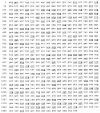Improved efficiency of a Salmonella-based vaccine against human papillomavirus type 16 virus-like particles achieved by using a codon-optimized version of L1
- PMID: 15542642
- PMCID: PMC524992
- DOI: 10.1128/JVI.78.23.12901-12909.2004
Improved efficiency of a Salmonella-based vaccine against human papillomavirus type 16 virus-like particles achieved by using a codon-optimized version of L1
Abstract
Cervical cancer results from cervical infection by human papillomaviruses (HPVs), especially HPV16. An effective vaccine against these HPVs is expected to have a dramatic impact on the incidence of this cancer and its precursor lesions. The leading candidate, a subunit prophylactic HPV virus-like particle (VLP) vaccine, can protect women from HPV infection. An alternative improved vaccine that avoids parenteral injection, that is efficient with a single dose, and that induces mucosal immunity might greatly facilitate vaccine implementation in different settings. In this study, we have constructed a new generation of recombinant Salmonella organisms that assemble HPV16 VLPs and induce high titers of neutralizing antibodies in mice after a single nasal or oral immunization with live bacteria. This was achieved through the expression of a HPV16 L1 capsid gene whose codon usage was optimized to fit with the most frequently used codons in Salmonella. Interestingly, the high immunogenicity of the new recombinant bacteria did not correlate with an increased expression of L1 VLPs but with a greater stability of the L1-expressing plasmid in vitro and in vivo in absence of antibiotic selection. Anti-HPV16 humoral and neutralizing responses were also observed with different Salmonella enterica serovar Typhimurium strains whose attenuating deletions have already been shown to be safe after oral vaccination of humans. Thus, our findings are a promising improvement toward a vaccine strain that could be tested in human volunteers.
Figures






Similar articles
-
Salmonella enterica serovar Typhi Ty21a expressing human papillomavirus type 16 L1 as a potential live vaccine against cervical cancer and typhoid fever.Clin Vaccine Immunol. 2007 Oct;14(10):1285-95. doi: 10.1128/CVI.00164-07. Epub 2007 Aug 8. Clin Vaccine Immunol. 2007. PMID: 17687110 Free PMC article.
-
Mucosal vaccination with a recombinant Salmonella typhimurium expressing human papillomavirus type 16 (HPV16) L1 virus-like particles (VLPs) or HPV16 VLPs purified from insect cells inhibits the growth of HPV16-expressing tumor cells in mice.Virology. 2001 Jan 5;279(1):354-60. doi: 10.1006/viro.2000.0717. Virology. 2001. PMID: 11145916
-
Human papillomavirus type 16 virus-like particles expressed in attenuated Salmonella typhimurium elicit mucosal and systemic neutralizing antibodies in mice.Infect Immun. 1997 Aug;65(8):3328-36. doi: 10.1128/iai.65.8.3328-3336.1997. Infect Immun. 1997. PMID: 9234794 Free PMC article.
-
Papillomavirus-like particle vaccines.J Natl Cancer Inst Monogr. 2001;(28):50-4. doi: 10.1093/oxfordjournals.jncimonographs.a024258. J Natl Cancer Inst Monogr. 2001. PMID: 11158207 Review.
-
Papillomavirus-like particles for serology and vaccine development.Intervirology. 1996;39(1-2):54-61. doi: 10.1159/000150475. Intervirology. 1996. PMID: 8957670 Review.
Cited by
-
Measurement of neutralizing serum antibodies of patients vaccinated with human papillomavirus L1 or L2-based immunogens using furin-cleaved HPV Pseudovirions.PLoS One. 2014 Jul 7;9(7):e101576. doi: 10.1371/journal.pone.0101576. eCollection 2014. PLoS One. 2014. PMID: 24999962 Free PMC article.
-
HPV Vaccines: today and in the Future.J Adolesc Health. 2008 Oct;43(4 Suppl):S26-40. doi: 10.1016/j.jadohealth.2008.07.010. J Adolesc Health. 2008. PMID: 18809143 Free PMC article. Review.
-
Salmonella enterica serovar Typhi Ty21a expressing human papillomavirus type 16 L1 as a potential live vaccine against cervical cancer and typhoid fever.Clin Vaccine Immunol. 2007 Oct;14(10):1285-95. doi: 10.1128/CVI.00164-07. Epub 2007 Aug 8. Clin Vaccine Immunol. 2007. PMID: 17687110 Free PMC article.
-
The rabbit papillomavirus model: a valuable tool to study viral-host interactions.Philos Trans R Soc Lond B Biol Sci. 2019 May 27;374(1773):20180294. doi: 10.1098/rstb.2018.0294. Philos Trans R Soc Lond B Biol Sci. 2019. PMID: 30955485 Free PMC article. Review.
-
How will HPV vaccines affect cervical cancer?Nat Rev Cancer. 2006 Oct;6(10):753-63. doi: 10.1038/nrc1973. Nat Rev Cancer. 2006. PMID: 16990853 Free PMC article. Review.
References
-
- Baud, D., J. Benyacoub, V. Revaz, M. Kok, F. Ponci, M. Bobst, R. Curtiss III, P. De Grandi, and D. Nardelli-Haefliger. 2004. Immunogenicity against human papillomavirus type 16 virus-like particles is strongly enhanced by the PhoPc phenotype in Salmonella enterica serovar Typhimurium. Infect. Immun. 72:750-756. - PMC - PubMed
-
- Benyacoub, J., S. Hopkins, A. Potts, S. Kelly, J.-P. Kraehenbuhl, R. Curtiss III, P. De Grandi, and D. Nardelli-Haefliger. 1999. The nature of the attenuation of Salmonella typhimurium strains expressing human papillomavirus type 16 virus-like particles determines the specific antibody responses in nasally immunized mice. Infect. Immun. 67:3674-3679. - PMC - PubMed
-
- Berg, O. G., and C. G. Kurland. 1997. Growth rate-optimised tRNA abundance and codon usage. J. Mol. Biol. 270:544-550. - PubMed
Publication types
MeSH terms
Substances
LinkOut - more resources
Full Text Sources
Other Literature Sources

